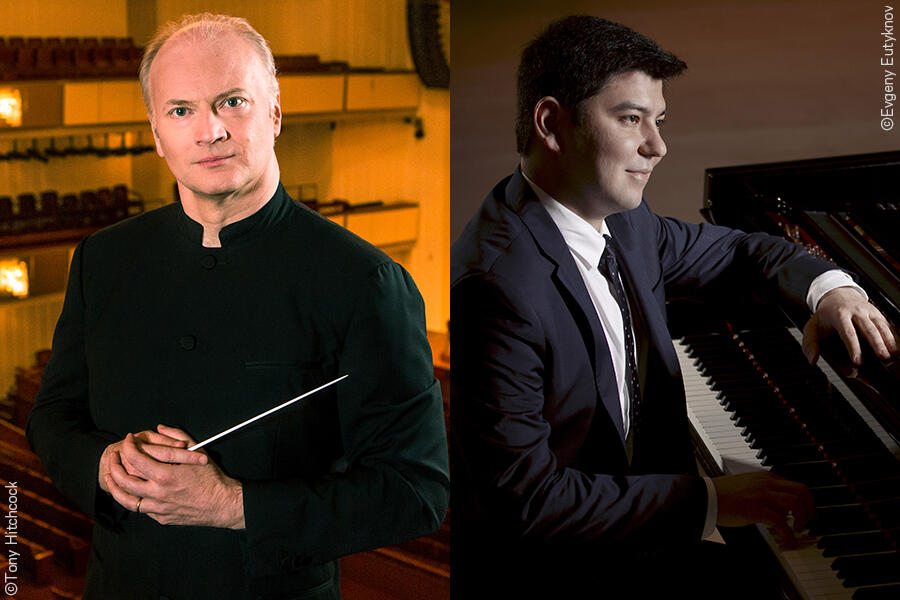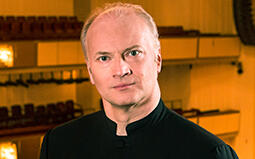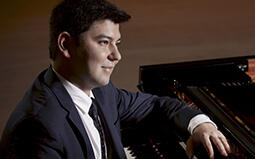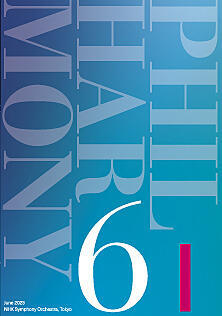- Home
- Concerts
- Subscription Concerts 2022-2023
- Program A
- No. 1986 Subscription (Program A)
No. 1986 Subscription (Program A)

Program
Prokofiev / The Love for Three Oranges Op. 33bis, symphonic suite
Following the 1917 Revolution, Prokofiev left his homeland in May 1918 by permission of the Soviet authorities to compose and perform overseas. Avoiding western disasters of war, he headed east for America via Vladivostok and Tokyo. During this voyage, he prepared the libretto for his opera based on The Love for Three Oranges by the Venetian playwright Carlo Gozzi (1720–1806). The opera would be first-staged in Chicago in 1921. The symphonic suite consists of six excerpts arranged by the composer.
The plot is wacky: everyone tries in vain to make the hypochondriac Prince laugh, but he does accidentally during a party seeing the Witch falling over. Furious, she puts a curse on him so he falls in love with three oranges that he goes in search of. The first two Princesses coming out of the enormous oranges die of thirst. The Prince marries the third Princess and expels the villains from the Kingdom. The best-known of the suite, the blatant March is from the scene where the sick Prince is forcibly carried from his bedroom to the party. At Scherzo, a rhythm of the Italian folk dance tarantella accompanies the hero' s feverish hunt for the oranges in the desert.
[Kumiko Nishi]
Prokofiev / Piano Concerto No. 2 G Minor Op. 16
Marked by a fierce modernism, the Piano Concerto No. 2 belongs to Prokofiev’s early period prior to the Bolshevik Revolution. The Ukraine-born Russian artist was still a twenty-one-yearold student when he began working on the piece in 1912. His forward-looking Piano Concerto No. 1 (1912) had created a stir establishing his status as an enfant terrible in the country’s music scene, but the more daring, radical, virtuosic concerto No. 2 aroused sharply divided reactions when it was premiered by the composer as soloist in 1913. Regrettably, this version’s score was lost amidst the chaos of the Revolution. Prokofiev reconstructed it from 1923 so the new version – the only one we know today – would be first heard in Paris in 1924.
No. 2 is unusual in its four movements all of which have their overall dark tone set by their main key (G or D minor). Requiring a technical prowess and physical toughness, the solo part is known as a most difficult one to play in piano literature. In fact, the opening sonata-like movement has a famously extended, demanding cadenza (pianist’s solo without orchestra) with dissonant sounds, and the second Scherzo movement dominated by perpetual motion has both the soloist’s hands play ceaseless sixteenth notes in unison. Headed “tempestoso,” the final movement in rondo-like form has indeed the stormy main section contrasted with the calmer central section unfolding a folkish theme.
[Kumiko Nishi]
Casella / Symphonic Fragments from La donna serpente [Japan Première]
Born in Turin, Casella speaks for Italian modern music along with Respighi. The former entered the Paris Conservatory in 1896 to be trained by Fauré. He since deepened his friendship with musicians active in the French capital including Ravel, before going back to Italy in 1915.
The general transition of Casella’s styles mirrors the vital times of music history, as his early works reflect influence of the late-Romanticism (Mahler and R. Strauss) and the Impressionism (Debussy), his middle period being more or less experimental adopting even Schönberg’s atonalism, while his later compositions after leaving France show neo-Classical approaches: in all cases, Casella's orchestral output – his strong field – is known for its expert, colorful scoring and solid sound.
Unlike Verdi or Puccini, Casella left us only three operas all of which date from his mature period in Italy. The first one, La donna serpente (The Serpent Lady) was composed in 1928–1931 to be premiered in 1932 in Rome. It is based upon an eighteenth-century fairytale play by, again, Carlo Gozzi whose works had inspired Puccini’s Turandot and Prokofiev’s above-mentioned piece. The intricate plot of Casella’s opera, often compared to Mozart’s Die Zauberflöte (Magic Flute), features the fairy princess Miranda who falls in love with and marries the mortal king Altidòr. Miranda’s father promises to make her mortal on condition that she tests her husband under cover: if he curses her, she shall be a snake. As Altidòr faces too severe trials to stand, she actually becomes a snake to be imprisoned, but he fights against monsters to rescue her. Miranda, mortal now, and Altidòr are reunited.
The Symphonic Fragments prepared by Casella comprises six movements divided into
two series. The opening movement Musica del sogno di re Altidòr (Music of King Altidòr’s Dream) takes a form of lullaby foretelling the couple’s misadventure. Its somnolent mood uncovered by the oboe solo recalls Debussy, while the wild Marcia guerria (Bellicose March) evokes Prokofiev’s March from The Love for Three Oranges. Marked by snaky, ominous melodies, the mysterious and dark Preludio (Prelude) suggests Miranda’s metamorphosis into a serpent.
[Kumiko Nishi]
Artists
 ConductorGianandrea Noseda
ConductorGianandrea Noseda
Italian conductor Gianandrea Noseda, born in Milan in 1964, is now serving as Music Director of the National Symphony Orchestra in Washington, D.C., sometimes dubbed the President’s orchestra, and as General Music Director of the Opernhaus Zürich having taken over from Fabio Luisi, thus he is active in both orchestral concerts and operas. He has continuously served in positions such as Principal Guest Conductor of the Mariinsky Theatre, Principal Conductor of the Cadaqués Orchestra, Spain, the BBC Philharmonic, and Music Director of Teatro Regio Torino. With the BBC Philharmonic, he has released numerous notable CDs of works of Respighi, Casella and Dallapiccola, and a disc of works of Russian composers he recorded with the London Symphony Orchestra, where he serves as Principal Guest Conductor, has also won high artistic acclaim. He actively takes up rarely performed works, discovers subtleties hidden in the work and fully draws out poetic and dramatic sentiments from them to reflect in the performances. We can only take off our hats to such a remarkable skill.
Since his first appearance with the NHK Symphony Orchestra in 2005, he has gradually built up good relations with the orchestra though his frequent visits. The programs he will conduct on this visit include the Japan premiere of Casella’s Symphonic Fragment from La donna serpente (The Serpent Lady), Symphony No.1, an ambitious work by Rakhmaninov whose 150th anniversary of birth falls on this year, and Shostakovich’s Symphony No. 8 — a highly attractive line-up of a variety of works which is typical of this conductor. We have great expectations for the enthusiastic collaboration of Maestro Noseda and the NHK Symphony Orchestra.
[Nobuyasu Matsuoka, music critic]
 PianoBehzod Abduraimov*
PianoBehzod Abduraimov*
Behzod Abduraimov, born in Tashkent, Uzbekistan in 1990, started to play the piano at the age of five, and made his professional debut by performing with the National Symphony Orchestra of Uzbekistan when he was around eight years old. After being trained under Tamara Popovich at the Uspensky State Central Academy in Tashkent, he studied at the Park University International Center for Music in the United States under the tutelage of Stanislav Ioudenitch, an Uzbek-born pianist who won the 2001 Van Cliburn International Piano Competition. He launched his international career after winning the 2009 London International Piano Competition, while releasing an album of Prokofiev’s Piano Sonata No. 6 and others in 2012, and an album containing Prokofiev’s Piano Concerto No. 3 in 2014. He has worked with the Philharmonia Orchestra, the Los Angeles Philharmonic, the San Francisco Symphony, the Orchestre de Paris and the Royal Concertgebouw Orchestra.
This is his second collaboration with the NHK Symphony Orchestra, his first being in 2014 when he played Rakhmaninov under Vladimir Ashkenazy. On this occasion, he will perform Piano Concerto No.2 of Prokofiev, his favorite composer.
[Haruka Kosaka, music journalist]
*Changed from initially scheduled.
Download
Ticket
Program A
No. 1986 Subscription (Program A)
NHK Hall
Google Map
Seating Chart
Single Tickets Release Date
Pre-sales for Subscribers:Wednesday, March 1, 2023
*about subscribers
Sale to General Public:Sunday, March 5, 2023
Price
| S | A | B | C | D | E | |
|---|---|---|---|---|---|---|
| Ordinary Ticket | 8,900 | 7,400 | 5,800 | 4,700 | 3,700 | 2,000 |
| Youth Ticket | 4,000 | 3,500 | 2,800 | 2,100 | 1,500 | 1,000 |
Seating chart Enlarge Print PDF
*tax included
*About Youth tickets (Available at N-Kyo Guide)
*Subscribers receive a 10% discount (Available at NHKSO WEB Ticket and N-Kyo Guide)
*For wheelchair-accessible seats, please refer to the N-Kyo Guide
Starting Dates of Ticket Sales
ANNUAL SUBSCRIPTION TICKETS Mon., July 18, 2022 11:00am
[For Subscribers: Thu., July 14, 2022 11:00am]
SEASONAL SUBSCRIPTION TICKETS (SPRING) Fri., Feb. 17, 2023 11:00am
[For Subscribers: Thu., Feb. 14, 2023 11:00am]
Youth Tickets
Youth Tickets are great options for those of 25 years old and younger
WEB Select 3 Plus
Choose three or more of your favorite concerts and get a discount on single tickets
*Only available at NHKSO WEB Ticket NHKSO WEB Ticket (Accesible from Japan only)
For further information and subscription application
N-Kyo Guide TEL:0570-02-9502
Other Ticket Agents
Broadcast
 NHK-FMNo. 1986 Subscription (Program A)
NHK-FMNo. 1986 Subscription (Program A)
Thursday, Jun 15, 2023 7:30PM - 9:10PM
Program:
Prokofiev / The Love for Three Oranges Op. 33bis, symphonic suite
Prokofiev / Piano Concerto No. 2 G Minor Op. 16
Casella / Symphonic Fragments from La donna serpente [Japan Première]
Conductor:Gianandrea Noseda
Piano:Behzod Abduraimov*
Recorded:June 10, 2023 NHK Hall


